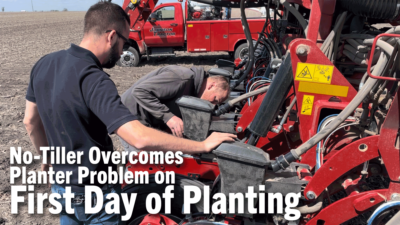Since the 1930s, the Sommer’s family has been farming the rolling fields of Champaign County, Ohio. Jack Sommers still lives in the farmhouse that his grandfather lived in when he purchased the farm over 90 years ago. Over the years, the farm has had a diverse mix of livestock, with pigs being one of the constants. It was only this past summer that Jack and his family sold the last of the sows and transitioned to strictly grain crop production.
Mark IV Farm is named after Jack’s son, Mark, who was killed in an accident, and includes Jack and his wife, along with his other son and daughter-in-law. The farm consists of approximately 750 acres of corn and soybeans along with some wheat and hay production.
“I started farming full time in 1995, and we have been 100% no-till ever since then. We have also been planting a lot of cover crops lately to learn more about how they help improve the soil,” Sommers said. “I retired from OSU Extension, and one of the things we were trying when I was the agriculture agent in the 1980s was to encourage area farmers to try no-till. My dad had started to no-till in 1983 and by 1995 we had converted everything to no-till. We started looking at cover crops in 2012 and now have 100% of our acres with cover crops as well.”
The topography of Champaign County makes much of the farmland a candidate for no-till and cover cropping practices.
“We have a farm that we rent that we call ‘the mountain farm’ that has up to 12% slopes. Here on this farm where we live, the slope is mostly 2% to 6%. That is where we got started with cover crops, because we were concerned about erosion and also nutrient uptake as we are relatively close to the intake for the Urbana city water supply,” he said. “Once we got started, we realized that there were a lot of other benefits to planting cover crops.”
Mark IV Farm is located in the Mad River watershed which feeds into the Miami River and on into the Ohio and Mississippi Rivers. Since it is spring-fed, the Mad River is unique in that it provides a cold-water habitat that supports trout. It does not have a lot of surface runoff going into it.
The soils that Sommers farms are fertile and black but with gravel underneath. They do not have a need for subsurface tile drainage.
“These soils are naturally well drained and in a wet year can yield very well. We can get the crop in early since the soil will warm up and dry out with the black color and natural drainage. We mainly have Fox and Lippincott soils on the farm. One of the big problems we have in this area is that if it stops raining in the summer and gets hot and dry, it hurts the crops. We have some areas that we have gotten zero yield in the past,” Sommers said.
Sommers feels that cover crops help protect the soils from run-off and build up organic matter to manage the water.
“We plant a cover crop mix. We include deep rooted species like radish and spreading roots species like rye, wheat and oats, and we also have clover to add nitrogen,” Sommers said. “There is a theory I like that focuses on feeding what’s living underneath the soil. That is one of the things that we are trying to do with these cover crops. We also use swine manure and the cover crops help capture the nutrients and hold them until the next growing season.”
Sommers advises that growers new to cover crops be patient and try different things to find what works for their operation.
“Early on we tried a lot of things that did not work very well. We started with our first cover crops spreading by air with rye grass into a standing crop. Sometimes it would take and sometimes it wouldn’t,” Sommers said. “From there we went to cereal rye with some wheat mixed in for a different root system. Eventually we purchased a precision spreader and spread the cover crop mix after the corn and soybean harvest. Depending on the crop rotation and cover crop mix, we will add crimson clover for more nitrogen and radish to go deep and help break up any compaction. We like the different root systems to try to keep things growing all the time and keep the bacteria and fungi working underground, even when it’s cold. We now plant green in the spring and terminate the cover crop with herbicide immediately after planting. We have found that letting it grow a little in the spring helps us to better manage spring water situation.”






Post a comment
Report Abusive Comment